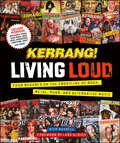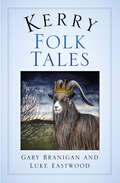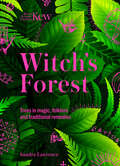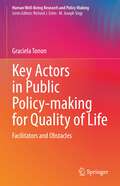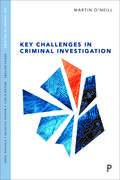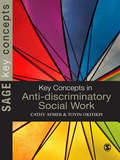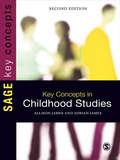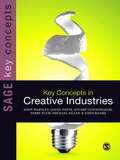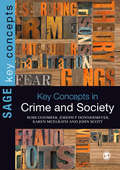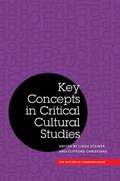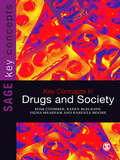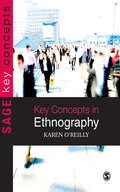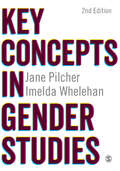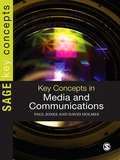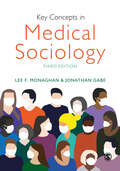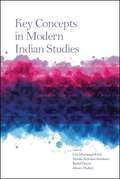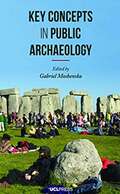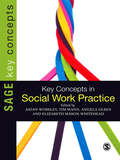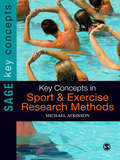- Table View
- List View
Kernel Density Estimation Based on Grouped Data: The Case of Poverty Assessment
by Camelia Minoiu Sanjay G. ReddyA report from the International Monetary Fund.
Kerrang! Living Loud: Four Decades on the Frontline of Rock, Metal, Punk, and Alternative Music
by Kerrang! Nick RuskellRelive the greatest moments in the last 40 years of hardcore, punk, and metal with this incredible book by Kerrang!, alternative music&’s most trusted publication. Celebrate 40 years of Kerrang! with this year-by-year review of the greatest artists and moments in metal and alternative music. Kerrang! has an unparalleled reputation as one of the world's best-loved rock-focused publications. It continues to be at the forefront of alternative music, flying the flag for metal, hardcore, punk, and beyond, introducing millions to their new favorite bands. Anyone who&’s anyone in the metal scene has featured Kerrang&’s hallowed pages and this unique book chronicles these appearances. If it happened in metal, Kerrang! covered it, as confirmed in this year-by-year survey of alternative music. By highlighting the heaviest albums, the most outlandish stars, the rowdiest mosh pits and the most incredible moments in rock history, fans are going to love it
Kerry Folk Tales
by Gary Branigan Luke Eastwood Elena DanaanNamed after the peoples of Ciarraige who inhabited the ancient territory, Kerry possesses a rich tapestry of history, legend and folklore unparalleled by many others. In this book, authors Gary Branigan and Luke Eastwood narrate a variety of myths and fables that will take you on a journey through Kerry’s past. Many of the stories have been handed down by local people from generation to generation, and reveal old customs and beliefs filled with superstition, while others are more modern, showing the continuance of the Irish traditions of the seanachaí and of Irish storytelling.
Kew - Witch's Forest: Trees in magic, folklore and traditional remedies
by Sandra Lawrence Royal Botanic KewThere is more folklore, mythology and magic associated with our trees and forests than with any other living things.Known throughout the world as dark and wild places where witches make mischief and eerie creatures dwell, forests are also places of sanctuary for the ancient magic and the most enchanting species of trees.Kew: Witch's Forest is a beautifully illustrated, captivating journey through the magical woodland and its stories, from birch broomsticks and the sacred olive, to alder doorways and the Tree of Life.
Kew - Witch's Forest: Trees in magic, folklore and traditional remedies
by Sandra Lawrence Royal Botanic KewThere is more folklore, mythology and magic associated with our trees and forests than with any other living things.Known throughout the world as dark and wild places where witches make mischief and eerie creatures dwell, forests are also places of sanctuary for the ancient magic and the most enchanting species of trees.Kew: Witch's Forest is a beautifully illustrated, captivating journey through the magical woodland and its stories, from birch broomsticks and the sacred olive, to alder doorways and the Tree of Life.
Key Actors in Public Policy-making for Quality of Life: Facilitators and Obstacles (Human Well-Being Research and Policy Making)
by Graciela TononThis book analyzes how quality of life research results can be transferred to policy making, and considers the role of actors in this process---researchers, policy makers, and citizens---as well as their interrelationships. This book points to the need to include actors other than the state in public policy-making related to quality of life and well-being issues, in defining problems and formulating alternatives. It identifies obstacles and facilitators in the process and offers a review of different types of aid that affect well-being and quality of life. Finally, it shows possible pathways for various stakeholders in policy-making to interact with one another in the building of good societies.
Key Challenges in Criminal Investigation (Key Themes in Policing)
by Martin O'NeillWhat are the current and future challenges in criminal investigation carried out by the police in the UK? How has the role of the detective changed over time and is there a real journey towards professionalism? Written by an author with extensive practical and training experience, this book provides a comprehensive overview and critical analysis of the development and practice of criminal investigation. It examines decision-making within criminal investigations, from volume crime through to major and serious crime investigations and links investigative influences on policing with the evidence-based agenda. The book: • discusses the move from the art and craft of detective work to a new science-based professionalism; • contextualises the current position of investigation within the context of government austerity measures and the College of Policing and Government agendas; • critically examines models of investigation such as the Core Investigative Doctrine and the Murder Investigation Manual; • explores the legal framework for modern critical investigations and the role of the IPCC. Part of Key themes in policing, a textbook series of evidence-based policing books for use within Higher Education curriculums and in practice, this book is suitable for policing and criminal justice programmes at undergraduate and postgraduate level.
Key Concepts in Anti-Discriminatory Social Work (SAGE Key Concepts series)
by Dr Toyin Okitikpi Dr Cathy Aymer"This is a key text that provides a well-rounded introduction to anti-discriminatory social work, placing this underpinning concept within the context of theory, methods, policy, legislation and skills. It will be of immense value to students, practitioners and service users. An excellent book!" John MacDonough, London South Bank University "Addressing both the ideas underpinning anti-discriminatory practice and more practice oriented approaches, this is an accessible book which will be of benefit to social work students and practitioners." Amanda Thorpe, University of Bedfordshire This Key Concepts clearly and concisely explains the basic ideas in the field of anti-discriminatory social work. It: - Explores the range of discriminations that people experience and discusses a number of theories that inform Anti-discriminatory practice - Considers the legal frameworks within which anti-discriminatory practice operates - Analyses the skills and knowledge required to practice effectively - Highlights the dynamic nature of anti-discriminatory practice and points the way towards a new practice dimension - Provides an essential reference guide for all social work students and practitioners, as well as those taking courses in teacher training, youth and community, nursing, mid-wifery and mental health studies for whom anti-discriminatory practice is an important element in their study.
Key Concepts in Childhood Studies (SAGE Key Concepts series)
by Allison James Adrian L James"Arranged alphabetically, core ideas about 'Agency' and 'Development' through to 'Socialisation' and 'Youth' are explained in straightforward language, with a concise introduction to key theoretical debates, as well as up to date references." - Martin Woodhead, The Open University "A challenging text that is recommended for all levels of the BA in Childhood Studies programme. The short, focussed chapters provide students with a comprehensive overview of a topic which they can then research in further depth." - Sharron Galley, Centre for Childhood Studies, Stockport College "This book gives a fantastic first look at many key concepts which are new to students in a way that is easily approachable and understandable. A great place to start further studies." - Kathryn Peckham, Chichester University This book has already proved itself as a market leader in Childhood Studies. All of the strengths of the First Edition have been retained. The book is comprehensive and judged with the needs of students in mind. It is a model of clarity and precision and has been acknowledged as such in reviews and course feedback. The new edition thoroughly revises old entries and adds new ones. The book is the most accessible, relevant student introduction to this expanding, interdisciplinary field. It is an indispensable teaching text and an ideal prompt for researchers.indispensable teaching text and an ideal prompt for researchers.
Key Concepts in Creative Industries (SAGE Key Concepts series)
by Stuart Cunningham John Hartley Michael Keane Terry Flew Dr John Banks Dr Jason Potts"This guide to the emerging language of creative industries field is a valuable resource for researchers and students alike. Concise, extensively referenced, and accessible, this this is an exceptionally useful reference work." - Dr Gauti Sigthorsson, Communication and Creative Arts, Greenwich University "There could be no better guides to the conceptual map of the creative industries than John Hartley and his colleagues, pioneers in the field. This book is a clear, comprehensive and accessible tool-kit of ideas, concepts, questions and discussions which will be invaluable to students and practitioners alike. Key Concepts in Creative Industries is set to become the corner stone of an expanding and exciting field of study" - Chris Barker, Associate Professor of Media and Cultural Studies, University of Wollongong, Australia Creativity is an attribute of individual people, but also a feature of organizations like firms, cultural institutions and social networks. In the knowledge economy of today, creativity is of increasing value, for developing, emergent and advanced countries, and for competing cities. This book is the first to present an organized study of the key concepts that underlie and motivate the field of creative industries. Written by a world-leading team of experts, it presents readers with compact accounts of the history of terms, the debates and tensions associated with their usage, and examples of how they apply to the creative industries around the world. Crisp and relevant, this is an invaluable text for students of the creative industries across a range of disciplines, especially media, communication, economics, sociology, creative and performing arts and regional studies.
Key Concepts in Crime and Society (SAGE Key Concepts series)
by John Scott Ross Coomber Joseph F. Donnermeyer Karen McElrathKey Concepts in Crime and Society offers an authoritative introduction to key issues in the area of crime as it connects to society. By providing critical insight into the key issues within each concept as well as highlighted cross-references to other key concepts, students will be helped to grasp a clear understanding of each of the topics covered and how they relate to broader areas of crime and criminality. The book provides an up-to-date, critical understanding on a wide range of crime related topics covering the major concepts students are likely to encounter within the fields of sociology, criminology and across the social sciences.
Key Concepts in Critical Cultural Studies
by Clifford Christians Linda SteinerThis volume brings together sixteen essays on key and intersecting topics in critical cultural studies from major scholars in the field. Taking into account the vicissitudes of political, social, and cultural issues, the contributors engage deeply with the evolving understanding of critical concepts such as history, community, culture, identity, politics, ethics, globalization, and technology. The essays address the extent to which these concepts have been useful to scholars, policy makers, and citizens, as well as the ways they must be rethought and reconsidered if they are to continue to be viable. Each essay considers what is known and understood about these concepts. The essays give particular attention to how relevant ideas, themes, and terms were developed, elaborated, and deployed in the work of James W. Carey, the "founding father" of cultural studies in the United States. The contributors map how these important concepts, including Carey's own work with them, have evolved over time and how these concepts intersect. The result is a coherent volume that redefines the still-emerging field of critical cultural studies. Contributors are Stuart Allan, Jack Zeljko Bratich, Clifford Christians, Norman Denzin, Mark Fackler, Robert Fortner, Lawrence Grossberg, Joli Jensen, Steve Jones, John Nerone, Lana Rakow, Quentin J. Schultze, Linda Steiner, Angharad N. Valdivia, Catherine Warren, Frederick Wasser, and Barbie Zelizer.
Key Concepts in Drugs and Society (SAGE Key Concepts series)
by Dr Fiona Measham Dr Karenza Moore Ross Coomber Karen Mcelrath'This is a great resource that reflects the huge expertise of the authors. It will be welcomed by students, researchers and indeed anyone wanting critical but comprehensive coverage of key issues and trends concerning drugs and society - locally and globally, historically and today.' - Nigel South, Professor of Sociology, University of Essex 'Provides informative, balanced and contextualized insights into the relationships between people and drugs. Whatever your background and however knowledgeable you feel you are about contemporary drug issues, I guarantee that you will learn something unexpected and new from this valuable text.' - Joanne Neale, Professor of Public Health, Oxford Brookes University Why do people take drugs? How do we understand moral panics? What is the relationship between drugs and violence? How do people's social positions influence their involvement in drug use? Insightful and illuminating, this book discusses drugs in social contexts. The authors bring together their different theoretical and practical backgrounds, offering a comprehensive and interdisciplinary introduction that opens up a wide scientific understanding moving beyond cultural myths and presuppositions. This is an invaluable reference source for students on criminology, sociology and social sciences programmes, as well as drug service practitioners such as drug workers, social workers and specialist nurses.
Key Concepts in Ethnography (SAGE Key Concepts series)
by Dr Karen O'ReillyAt last, an accessible, authoritative, non-nonsense guide to the key concepts in one of the most widely used methodologies in social science: Ethnography. The book: - Covers and summarises the basic and related issues in ethnography that are covered nowhere else in a single text - It is an outstanding teaching and research resource which examines topics like 'sampling' and 'generalising' as well as embracing new fields such as virtual, visual and multi-sighted ethnography. - Time-honoured themes such as key informants, access, participant observation and rapport are here as well as key contemporary issues such as reflexivity, writing and ethics. - Each concept is presented comprehensively yet critically, with relevant examples. This is not quite an encyclopaedia but far more than a dictionary. It is comprehensive yet brief. It is small and neat, easy to hold and flick through. It is what students and researchers have been waiting for.
Key Concepts in Gender Studies (SAGE Key Concepts series)
by Imelda Whelehan Jane PilcherThe new edition of Key Concepts in Gender Studies is a lively and engaging introduction to this dynamic field. Thoroughly revised throughout, the second edition benefits from the addition of nine new concepts including Gender Social Movements, Intersectionality and Mainstreaming. Each of the entries: begins with a concise definition outlines the history of each term and the debates surrounding it includes illustrations of how the concept has been applied within the field offers examples which allow a critical re-evaluation of the concept is cross-referenced with the other key concepts ends with guidance on further reading. A must-buy for undergraduate and postgraduate students in a range of social science and humanities disciplines.
Key Concepts in Gender Studies (SAGE Key Concepts series)
by Imelda Whelehan Jane PilcherThe new edition of Key Concepts in Gender Studies is a lively and engaging introduction to this dynamic field. Thoroughly revised throughout, the second edition benefits from the addition of nine new concepts including Gender Social Movements, Intersectionality and Mainstreaming. Each of the entries: begins with a concise definition outlines the history of each term and the debates surrounding it includes illustrations of how the concept has been applied within the field offers examples which allow a critical re-evaluation of the concept is cross-referenced with the other key concepts ends with guidance on further reading. A must-buy for undergraduate and postgraduate students in a range of social science and humanities disciplines.
Key Concepts in Media and Communications (SAGE Key Concepts series)
by Paul Jones Dr David Holmes"A sprightly, critical and intelligent guided tour around the mansion of media and communications/cultural research... enormously useful for students and researchers." - James Curran, Goldsmiths, University of London "A highly comprehensive guide to core concepts in media theory and criticism." - Andrew Goodwin, University of San Francisco "A great resource for new under-grads and something I urge my students to buy and use as a hand first 'port of call' throughout their studies." - Paul Smith, De Montfort University This book covers the key concepts central to understanding recent developments in media and communications studies. Its index also provides further points of entry. Wide-ranging in scope and accessible in style it sets out a useful, clear map of the important theories, methods and debates. The entries critically explore the limits of a key concept as much as the traditions that define it. They include clear definitions, are introduced within the wider context of the field and each one: is fully cross-referenced is appropriately illustrated by the use of examples, tables and diagrams provides a guide to further reading This book is an essential resource for students in media and communications and for those studying sociology, cultural sociology, cultural studies and sociology of media.
Key Concepts in Medical Sociology (SAGE Key Concepts series)
by Lee F. Monaghan Jonathan GabeHow do we understand health in relation to society? What role do social processes, structures and culture play in shaping our experiences of health and illness? How do we understand medicine and healthcare within a sociological framework? Drawing on international literature and examples, this new edition of Key Concepts in Medical Sociology: · Systematically explains the concepts that have preoccupied medical sociology from its inception, and which have shaped the field as it exists today. · Includes new entries, such as pandemics and epidemics, the environment, intersectionality, pharmaceuticalization, medical tourism and sexuality. · Begins each entry with a definition of the concept then examines its origins, development, strengths and weaknesses, and concludes with suggested further reading for independent learning. Key Concepts in Medical Sociology is essential reading for students in medical sociology as well as those undertaking professional training in health-related disciplines.
Key Concepts in Medical Sociology (SAGE Key Concepts series)
by Lee F. Monaghan Jonathan GabeHow do we understand health in relation to society? What role do social processes, structures and culture play in shaping our experiences of health and illness? How do we understand medicine and healthcare within a sociological framework? Drawing on international literature and examples, this new edition of Key Concepts in Medical Sociology: · Systematically explains the concepts that have preoccupied medical sociology from its inception, and which have shaped the field as it exists today. · Includes new entries, such as pandemics and epidemics, the environment, intersectionality, pharmaceuticalization, medical tourism and sexuality. · Begins each entry with a definition of the concept then examines its origins, development, strengths and weaknesses, and concludes with suggested further reading for independent learning. Key Concepts in Medical Sociology is essential reading for students in medical sociology as well as those undertaking professional training in health-related disciplines.
Key Concepts in Modern Indian Studies
by Rachel DwyerModern Indian studies have recently become a site for new, creative, and thought-provoking debates extending over a broad canvas of crucial issues. As a result of socio-political transformations, certain concepts—such as ahimsa, caste, darshan, and race—have taken on different meanings. Bringing together ideas, issues, and debates salient to modern Indian studies, this volume charts the social, cultural, political, and economic processes at work in the Indian subcontinent. Authored by internationally recognized experts, this volume comprises over one hundred individual entries on concepts central to their respective fields of specialization, highlighting crucial issues and debates in a lucid and concise manner. Each concept is accompanied by a critical analysis of its trajectory and a succinct discussion of its significance in the academic arena as well as in the public sphere. Enhancing the shared framework of understanding about the Indian subcontinent, Key Concepts in Modern Indian Studies will provide the reader with insights into vital debates about the region, underscoring the compelling issues emanating from colonialism and postcolonialism.
Key Concepts in Public Archaeology
by Gabriel MoshenskaThis book provides a broad overview of the key concepts in public archaeology, a research field that examines the relationship between archaeology and the public, in both theoretical and practical terms. While based on the long-standing programme of undergraduate and graduate teaching in public archaeology at UCL’s renowned Institute of Archaeology, the book also takes into account the growth of scholarship from around the world and seeks to clarify what exactly ‘public archaeology’ is by promoting an inclusive, socially and politically engaged vision of the discipline. <p><p> Written for students and practitioners, the individual chapters provide textbook-level introductions to the themes, theories and controversies that connect archaeology to wider society, from the trade in illicit antiquities to the use of digital media in public engagement, and point readers to the most relevant case studies and learning resources to aid their further study. <p><p> This book was produced as part of JISC's Institution as e-Textbook Publisher project. Find out more at https://www.jisc.ac.uk/rd/projects/institution-as-e-textbook-publisher
Key Concepts in Social Gerontology (SAGE Key Concepts series)
by Sarah Hillcoat-Nalletamby Kristine J. Ajrouch Judith E. PhillipsSocial gerontology is a new and dynamic field reflecting the increasing interest in ageing across the world. This book provides a readily accessible guide to well established and contested issues, as well as new concepts emerging through cutting edge research in the discipline. The entries give concise, lucid knowledge on what constitutes the 'building blocks' of social gerontology and sets out a clear review of the core concepts, both classic and emerging, in this subject area. Each concept is explored in terms of its: * History * Application * Usefulness to theory and research * Significance in practice They go beyond simple definition of the concepts to look at how each issue has shaped the discipline of social gerontology today. This book is authored by social gerontologists from the UK and the USA. Together they present an interdisciplinary perspective and reflect a global approach to the presentation of key concepts in social gerontology. Judith Phillips is Professor of Gerontology and Social Work at Swansea University, Wales Kristine Ajrouch is Associate Professor of Sociology at Eastern Michigan University Sarah Hillcoat-Nallétamby is Senior Lecturer in Social Policy at Swansea University, Wales
Key Concepts in Social Research (SAGE Key Concepts series)
by Geoff Payne Judy Payne`This clearly written and user-friendly book is ideal for students or researchers who wish to get a basic, but solid grasp of a topic and see how it fits with other topics. By following the links a student can easily and efficiently build up a clear conceptual map of social research' - Malcolm Williams, Reader in Sociology, Cardiff University `This is a really useful book, written in an accessible manner for students beginning their study of social research methods. It is helpful both as an introductory text and as a reference guide for more advanced students. Most of the key topics in methods and methodology are covered and it will be suitable as a recommended text on a wide variety of courses' - Clive Seale, Brunel University At last, an authoritative, crystal-clear introduction to research methods which really takes account of the needs of students for accessible, focused information to help with undergraduate essays and exams. The key concepts discussed here are based on a review of teaching syllabi and the authors' experience of many years of teaching. Topics range over qualitative and quantitative approaches and combine practical considerations with philosophical issues. They include several new topics, like internet and phone polling, internet searches, and visual methods. Each section is free-standing, can be tackled in order, but with links to other sections to enable students to cross-reference and build up a wider understanding of central research methods. To facilitate comprehension and aid study, each section begins with a definition. It is followed by a summary of key points with key words and guides to further reading and up-to-date examples. The book is a major addition to undergraduate reading lists. It is reliable, allows for easy transference to essays and exams and easy to use, and exceptionally clearly written for student consumption. The book answers the needs of all those who find research methods daunting, and for those who have dreamt of an ideal introduction to the subject.
Key Concepts in Social Work Practice (SAGE Key Concepts series)
by Elizabeth Mason-Whitehead Angela Olsen Tim Mann Aidan WorsleyThis book is a quick and accessible reference guide to the key concepts that social work students and professionals need to understand to be effective. The authors place practice at the centre of the text, and include a host of case examples to bring the concepts to life. Examining the essential topics of the social work curriculum, the concepts covered relate to practice, theory, policy and personal challenges. Further reading is included in each entry, so that the reader can explore what they have learned in more detail. This book will be an invaluable resource for social work students during their studies and on their practice placement. It will also be useful for qualified social workers, who want to continue their professional education.
Key Concepts in Sport and Exercise Research Methods (SAGE Key Concepts series)
by Dr Michael Atkinson"What a helpful book! This will be a 'friend ' to many undergraduate students looking for clarification." - Helen Hazelwood, St Mary's University College "This is a great book that really helps the students understand research and the complex processes that can often daunt even the most intelligent students." - Phil Barter, Middlesex University "Few can bring research methods to life like Mike Atkinson. His breadth of research interests and experience mean he can introduce you to all you need to know and inspire you to get down to doing some research yourself." - Dominic Malcolm, Loughborough University This book systematically demonstrates the significance and application of research methods in plain language. Written for students, it contains the core methodological concepts, practices and debates they need to understand and apply research methods within the field of sport and exercise. It provides a comprehensive panoramic introduction which will reassure and empower students. Written by a leading academic and drawing on years of teaching experience, it includes carefully cross-referenced entries which critically engage with interdisciplinary themes and data. Each concept includes: clear definitions suggestions for further reading comprehensive examples practical applications Pragmatic, lucid and concise the book will provide essential support to students in sports studies, sport development, sport and exercise science, kinesiology and health.

